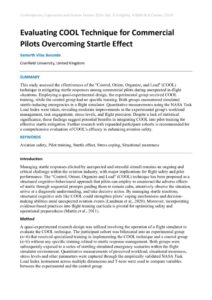| Document | Author Samarth Vilas Burande |
| Abstract This study assessed the effectiveness of the "Control, Orient, Organize, and Lead" (COOL) technique in mitigating startle responses among commercial pilots during unexpected in-flight situations. Employing a quasi-experimental design, the experimental group received COOL training, while the control group had no specific training. Both groups encountered simulated startle-inducing emergencies in a flight simulator. Quantitative measurements using the NASA Task Load Index were taken, revealing moderate improvements in the experimental group's workload management, task engagement, stress levels, and flight precision. Despite a lack of statistical significance, these findings suggest potential benefits in integrating COOL into pilot training for effective startle mitigation. Further research with expanded participant cohorts is recommended for a comprehensive evaluation of COOL's efficacy in enhancing aviation safety. |

